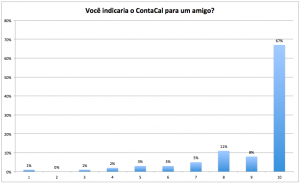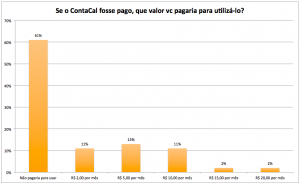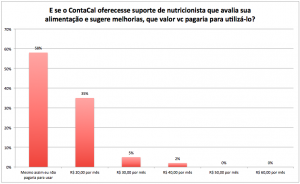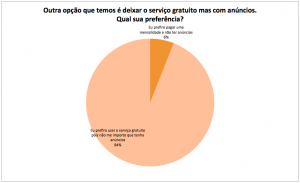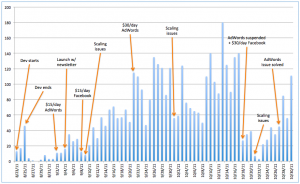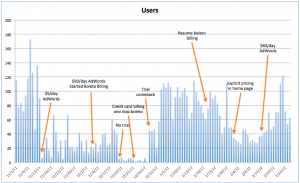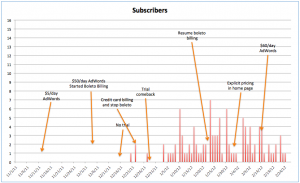Restriction driven simplicity
20 de janeiro, 2012O que é o Guia da Startup e de Gestão de Produtos de Software?
9 de março, 2012My lean startup experiment is an experiment I’m running to see if it is possible to launch a successful product (product = customer facing software system) without spending too much money and in a short period of time.
In phase 1 I had 5 product ideas and wanted to know in which should I invest.
In phase 2 I pick the idea with more interest from phase 1 and invested in creating the MVP (Minimal Viable Product), ContaCal, a calorie counter system.
In phase 3 I launched the website, the online campaign, got real users feedback and improved the system based on this feedback.
My phase 4 main objective was the search for revenue!
Costs for changing the system was getting too expensive
I was getting at a point were I needed minor changes to the system and every change to the system was going to cost me too much, not only in money but in time, since freelance developers are not available whenever you need them. I’m an old programmer… My last production code was in Perl. At that time, Microsoft ASP was new stuff and no one ever heard of PHP. This was 1998.
As soon as I got the database access, I wrote a simple Perl application to generate statistics so I could check how the app was going, how many users signed up and so on.
Due to my familiarity with Perl I was tempted to write more code using this language but since this is an experiment, I decided to get the source code from the source code repository (GitHub), try to run the application locally on my machine, make some changes, test it, send it back to GitHub and then deploy in production. It worked! 🙂
Now the doors were really open to full experimentation. The site was based on WordPress, so I could change it to certain degree anytime I wanted. And now the application I could also change – to a certain degree – anytime I wanted, so it’s time for some experiments.
Prior to revenue, a survey
Prior to charging users for using the system I decided to run a survey so I could have a better understanding of how the users view the product. The first question was about the NPS (Net Promoter Score), a customer loyalty metric:
The Net Promoter Score is obtained by asking customers a single question on a 0 to 10 rating scale, where 10 is “extremely likely” and 0 is “not at all likely”: “How likely is it that you would recommend our company to a friend or colleague?” Based on their responses, customers are categorized into one of three groups: Promoters (9–10 rating), Passives (7–8 rating), and Detractors (0–6 rating). The percentage of Detractors is then subtracted from the percentage of Promoters to obtain a Net Promoter score (NPS). NPS can be as low as -100 (everybody is a detractor) or as high as +100 (everybody is a promoter). An NPS that is positive (i.e., higher than zero) is felt to be good, and an NPS of +50 is excellent. Companies are encouraged to follow this question with an open-ended request for elaboration, soliciting the reasons for a customer’s rating of that company or product.
Source: Wikipedia
ContaCal’s NPS was 65%, a very good index.
The second question was about how much the user was willing to pay for the service.
39% of the users were willing to pay for the service and the average price they were willing to pay was around 5 BRL per month.
We also asked about nutritionist counseling as part of the service and in this scenario, 42% of the respondents were willing to pay an average price of 20 BRL.
The last question was about ad supported business model. I was not surprised that 94% of the users preferred the free ad supported option.
The search for revenue
My first experiment was with ads. The option at hand was Google AdSense, so I implemented it in the website as well as inside the application. The results were not very compelling. 🙁
I experimented with AdSense during one month. I had close to 85K pageviews and 20.5K unique visitors. This generated U$ 32.19 in revenue.
Next step was billing. Here in Brazil we have boleto bancário, an alternative to credit card for receiving payments.
Boleto Bancário is a financial document, a kind of proforma invoice issued by a bank that enables your client to pay the exact specified amount to the receiving party (merchant). As long as within the due date period, your client may use a lotto house, supermarkets, post offices, home banking in addition to any bank agency in the Brazilian territory.
Source: The Brazil Business
I implemented initially boleto bancário using Cobre Grátis service. I had some issues that made me change to credit card. For credit card processing I used PayPal. Quite useful since they provide recurring payments as well as international payments, which was quite handy since ContaCal was also attracting some users from other Portuguese speaking countries and I do have a few subscribers from abroad! 🙂
After using credit card only lots of user were asking for boleto, so now I offer both options.
Some time ago I showed my initial user statistics:
Below you can find the follow on statistics up to February 2012, not only for users but also subscribers:
One thing that is really important is to have a log of all the tests made so you can relate each of the experiments to the numbers you see in your charts.
The results
Below are the results of 6 months of my lean startup validation experiment.

ContaCal numbers
Under Mkt costs is AdWords and Facebook Ads. Under Infra costs are all infrastructure costs including hosting, email marketing tool, domain registration, unbounce and any other SaaS tool required to run ContaCal. Under Dev are all the development costs including not only the Startup DEV but also the WordPress theme acquired at themeforest as well as the designer who worked on implementing the theme in the WordPress.
Now I need to work on reducing those costs as well as keeping the revenue growth.
Next phase: the search for profit
Since I was able to find some revenue, now it is time to search for profit. Some of the areas I’ll work on during next phase:
- reduce advertising costs by improving AdWords usage
- reduce infrastructure costs by optimizing its usage
- price increase
- usability review
See you there! 🙂

